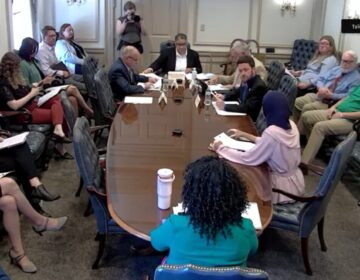50 years later, lessons from the Storm of ’62
It lasted for five high tides, was responsible for seven deaths in Delaware and dramatically changed the way state leaders plan for construction on the coast.
The storm of ’62. A March nor’easter that whipped strong winds, pounding surf and flood waters along the Mid-Atlantic coast. The storm brought waves as high 20 – 40 feet and extensive flooding. The town of Dewey Beach was completely underwater. The force of the water deposited sand on the town three o r four feet deep.
Reliving the storm
The force of the storm and its aftermath were captured in the documentary The ’62 Storm — Delaware’s Shared Response produced by 302 Stories. In the film, survivors of the storm talk about what they went through. “It was like the waves were actually breaking on the buildings,” says Jay Stevenson of Rehoboth Beach. Hazel Brittingham of Lewes remembers the shock and fear she felt, “I looked and saw a wall of water. And I can remember that I didn’t intend to scream, but I screamed.”
One of the worst parts of the massive storm was that residents had little or no warning that it was coming. John Moyer, Jr. of Bowers Beach says he “woke up one morning for school, and my mother said, ‘Look out your window.’ And we could actually see three houses floating across the marsh. And I mean they were moving.” The storm demonstrated the power of water to John Ferguson, Col. (Ret.) Delaware State Police. “We watched this storm pick up a five room bungalow, stand it right on its end and just beat it to pieces, in about an hour that building was completely gone,” says Ferguson in the documentary.
While there weren’t nearly as many businesses at Delaware’s beaches as their are now, one very familiar store was ravaged by the pounding storm. Portions of the Rehoboth Beach landmark Dolle’s on the boardwalk fell into the sea. “I remember very well watching Dolle’s from the side from that view just crash in and the windows and the glass just falling,” says Melissa Thoroughgood of Rehoboth Beach.
Lessons learned
50 years later, the storm is a distant memory, the boardwalk has been rebuilt (more than once) and more homes and businesses have moved into Delaware’s beach communities. But the affects of the Storm of ’62 continue to linger.
Part of the reason the storm was so damaging was the lack of building standards along the beach. “Over the course of the decades, the 50 years since that storm, we have seen a dramatic improvement in the construction standards of buildings along the coast,” says Tony Pratt, administrator of the state’s Shoreline and Waterway Management Section. “We’ve seen a much better awareness of the amount of force storm waves, storm tides, duration of storms, frequency of storms that we’re likely to encounter here at the coast,” Pratt says. “With that better equipment, that better knowledge-base we have, we can do a lot better in making people safe during storms.
Maintaining a wide beach is also part of the state’s effort to prevent a repeat of the 62 storm. “The wide beach we have here in Rehoboth today is a product of the corps of engineers and the state of Delaware Department of Natural Resources and Environmental Control nourishing this beach and creating a beach that’s tremendously wider than it was even in 1962.”
It will happen again
Looking back at the ’62 storm is a bit disconcerting, partly because of the potential for a repeat. “This storm will occur again. It may not even be in my lifetime, but it will occur again, and even in fact one larger than this could and possibly will occur,” says Pratt. “It could occur next week, it could occur 27 years from now.”
The potential impact of another “Storm of 62” could be even more devastating. If the predictions for an increase in sea level become a reality, average high tides will affect areas that currently stay dry during high tides. If a nor’easter like the ’62 storm were to combine an increased sea level, the damage could be catastrophic. (The state has published maps online that show how far high tides could reach with an increased sea level.)
“What does the future hold? Take the ’62 storm and if we have the accelerated rates of sea level rise into the future that they’re predicting, and put that storm on top of a sea that may be one two or three feet higher than they are today, then all bets become just negated. We can’t take those risks”
The changes implemented over the past 50 years will be among the topics of discussion on Wednesday, March 7 as DNREC hosts a workshop on the Storm of ’62. The workshop will be held at the Rehoboth Beach Convention Center and is designed for local government leaders, developers, residents and anyone interested in how one storm changed the way we build at the beach. The workshop includes a showing of The ’62 Storm documentary. You can watch the film on WHYY’s Y-Info channel (over the air on 12.3, Comcast 258, FiOS 473) on March 8 at 9 p.m.
WHYY is your source for fact-based, in-depth journalism and information. As a nonprofit organization, we rely on financial support from readers like you. Please give today.




